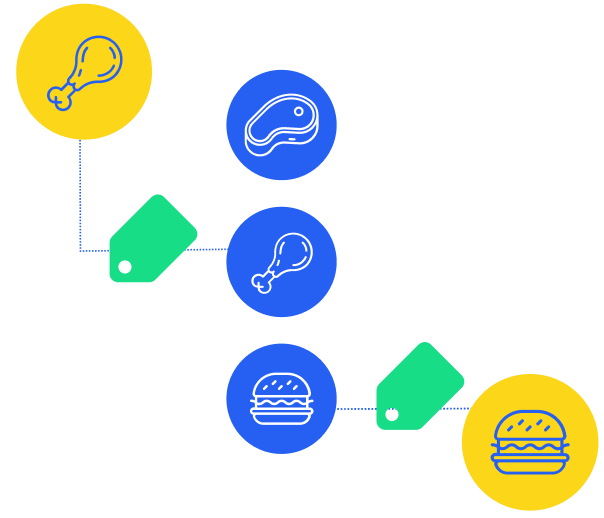Complete Guide To
Optimizing your site’s performance means constant monitoring. The world of digital marketing is dynamic and fast-paced, and monitoring tools let you keep your finger on the pulse of that environment. Tools like Google Analytics arm you with invaluable information on how visitors interact with your site. The downside is that these tools rely on tags, and too many tags can clutter a site, making it clunky and unresponsive. In this way, marketers can’t have their cake and eat it too – more tags mean better tracking but poorer technical performance.

With Google Tag Manager, data-gathering and site performance are no longer mutually exclusive. In fact, GTM improves site performance in both marketing and IT terms. In this chapter we’ll explain how GTM can enhance your site’s functionality, from data accuracy to SEO performance to loading times. We’ll conclude with brief case studies of several well-known companies that have had success with GTM.
Strategy requires data, and data requires tags. Think of the Internet as the human body. JavaScript tags – snippets of code that control page execution – are the body’s nerve synapses. Tags are how your site detects, remembers, monitors, executes, and reacts. They load your site’s content, transmit information, and deliver advertising.
The problem is that the more tag activity a page has, the slower its load times. GTM drastically reduces load times by addressing the three culprits of tag congestion: synchronous (serial) tag loading, excessive calls to external resources, and redundant data-layer requests. That probably doesn’t mean much to you now, but it will.
Asynchronous Tag Loading

Any IT guru will tell you that JavaScript is the leading cause of sluggish web pages. The reason is something IT calls “blocking,” meaning JavaScript is stopping everything else from happening until it loads. Blocking occurs when browsers load tags synchronously, which means a page element cannot load until the one before it has. Primarily, a page renders its HTML and CSS first, but the loading of CSS can be blocked by JavaScript until it finishes executing.
GTM eliminates blocking by firing all tags on a page asynchronously. In other words, tags load as soon as they’re ready. They don’t have to wait for other tags to load first, and other tags don’t have to wait for them. GTM fires tags parallel to one another instead of in a strict sequence, potentially shaving seconds off your pages’ load times.
Minimal Calls to External Resources
The second reason JavaScript tags slow pages down is excessive calls to outside resources in the code. The more individual tags you have, the more calls a page will have. GTM streamlines the number of requests to external sources by using a single snippet of code to control all your page’s tags. GTM thus reduces the number of calls your visitor’s browser has to make to just one.

Consolidating Data in the Data Layer
Multiple requests for the same data are the final tag-related source of site lethargy. The more complex and diverse your digital marketing toolkit, the more redundant your data requests will be. For instance, say you report the details of sales on your site as conversions to AdWords, Google Analytics, and AdRoll. If you deployed the services’ tags individually, they would request the same data about each purchase three separate times. GTM consolidates these requests by creating a single point of reference – the data layer – from which all three services can cull the information they need.
To understand the data layer’s impact on efficiency, think of your site like a restaurant where tags are diners and data is food. Without tag management, every time Google Analytics walks in and orders fried chicken, a server has to scurry over, take its order, run in the back, wait for the food, plate the food, and serve it. The process repeats when AdWords walks in ravenous at the same time demanding fried chicken.

With GTM, the data layer becomes like a buffet in the middle of your restaurant. Rather than wasting time and resources serving different customers the same dish, you create a data layer for tags to help themselves. Tags get their meals faster, and your restaurant runs more efficiently as a result.

You’re probably convinced by now that Google Tag Manager can help your site run faster. But so what? Shaving a second or two off a page’s load time might make IT’s day, but it’s not like it will help sales or bump up your rankings on Google, right? Wrong. Consider the following statistics published by the Search Engine Journal:
> Amazon.com has reported that a delay of 0.1 seconds in a page’s load time can cause a one-percent decline in customer activity.
> AOL reported a 30-percent variance in page visits based solely on load time.
> 51 percent of U.S. shoppers claim they will abandon a purchase if a site takes too long.
> A site that takes six seconds to load experiences a 50-percent conversion decline.
> 47 percent of Internet users expect a site to load in less than two seconds.
> 75 percent of consumers would visit a competing site rather than deal with a slow page in peak traffic periods.
The takeaway is this: Slow-loading pages drive visitors away. One lethargic page could cost you a crucial first impression or force visitors to competitors’ sites. Frustrated visitors don’t become customers. This is one of the many ways that time is money in the world of digital marketing. Slow-loading pages are not just an IT headache; they’re a conversion killer.

And the consequences don’t stop there. Sluggish load times hurt search rankings, which means you’ll kiss a good chunk of organic traffic goodbye. Google has used site speed in its search ranking algorithm since 2010. Slow-loading pages, especially on your mobile site, will affect your presence in searches that bring visitors to your site in the first place.
GTM can help your site run faster without compromising your data collection by streamlining your tracking codes. Instead of having dozens of individual codes on a page, GTM consolidates individual tags into a single snippet of code. You get all the data without the sluggishness.
If you’ve dealt with tags for any length of time, you can probably identify with one or more of the following scenarios. You realize that one of your site’s pages is missing Google Analytics. By the time you notice it, how much irretrievable data have you missed? Alternatively, you might notice a redundant Google Analytics tag on a page, corrupting your data. Remember that double-tagging can still occur with GTM if there’s a GA tag and an old GA tag on the same page.
Events like these are the norm with manual tag management. Manually tagging is an error-prone process that can quickly overwhelm IT as pages become littered with tags. Sooner or later, you lose visibility to what tags are on each page and what their statuses are. Data accuracy suffers as your tag hierarchy becomes saturated with inactive, superfluous, and outdated tags. The data you collect are either erroneous or incomplete, resulting in flawed analytics.

Google Tag Manager can help restore your analytics’ veracity. GTM deploys tags consistently across your pages, keeping your measurements relevant and continuous. Tag management also lets you to add sophisticated tracking measurements that would be prohibitively difficult to implement manually. The result is unparalleled analytics accuracy to bolster your strategic decisions.
The list of companies that have enhanced their sites with GTM is a long and illustrious one. Airbnb, GoPro, Regus, and Rail Europe are just a few of the businesses that have implemented GTM with great success. Read on for brief case studies of a few of these companies and the results GTM gave them.

Airbnb
If you ever need a rental for a steal, Airbnb is the place to go. Airbnb is an online marketplace where people can list and book alternative travel accommodations. The company uses a large number of tags on its site, including tags for several vendors tracking various kinds of conversions and a unique tag for each of its AdWords accounts. Airbnb had to replicate certain tags multiple times to meet different vendors’ needs, and the site quickly became unwieldy. Before GTM, the company had 88 different audience lists and 100 separate tags!
In desperate need of tag management, Airbnb first tried a paid system that still required IT expertise to implement tags. The solution was also pricy and required add-on tools for reporting and quality assurance (QA). The company then turned to the free Google Tag Manager. The result was unprecedented synchronicity between IT and marketing.
Here’s what Airbnb’s software engineer on the project, Mona Gandhi, had to say about GTM: “With Google Tag Manager, it’s a matter of an hour or so from receiving a tag to testing to QA to deployment. It’s exponentially better”. Specifically, Airbnb reported the following results:
> Reduced tag deployment from days to hours;
> Improved launch times of new vendors, tools, and programs;
> Increased page load times by eight percent; and
> Improved data accuracy, SEO, and ROI.

Rail Europe: Jettisoning Unnecessary Code Leads to Radical Reductions in Load Times
North America’s biggest distributor of European rail products, Rail Europe, maintains 20 domains in its portfolio. You can imagine how unwieldy manual tag management became for the company with so many sites in different countries, languages, and currencies. The portfolio’s complexity forced marketing to depend heavily on an oversubscribed IT department with an already massive queue. Additionally, the complicated process of implementing and managing so many tags kept IT occupied with repetitive tagging tasks, leaving little time for them to focus on improving the site’s functionality.
The albatross that was manual tag management at Rail Europe was costing marketing precious insights and causing IT a never-ending headache. Something had to give. Rail Europe needed an efficient way to organize all of their domains’ tags at the same time. The company’s director of Online Marketing, Lothaire Ruellan, found exactly what Rail Europe was looking for in GTM, which was also easy on the budget.
With GTM, Rail Europe could do things never before possible. They sent custom data to GTM once via the data layer, making it available to any third-party tags. The company also appreciated GTM’s custom HTML option, which let it deploy the tags of six different vendors.
After getting a taste of GTM’s potential, Ruellan was thrilled with his decision. “With Google Tag Manager, we can literally deploy a tag in minutes and provide marketing partners with all the custom data they might need,” he said. “Now, we’re better equipped to optimize our digital campaigns than ever.”
The results strongly support his enthusiasm. Not only did Rail Europe cut their tag deployment lag time from months to days with GTM, but they also eradicated enough superfluous code to slash page load times by 20 percent.
Optimizing your site’s performance means constant monitoring. The world of digital marketing is dynamic and fast-paced, and monitoring tools let you keep your finger on the pulse of that environment. Tools like Google Analytics arm you with invaluable information on how visitors interact with your site. The downside is that these tools rely on tags, and too many tags can clutter a site, making it clunky and unresponsive. In this way, marketers can’t have their cake and eat it too – more tags mean better tracking but poorer technical performance.

With Google Tag Manager, data-gathering and site performance are no longer mutually exclusive. In fact, GTM improves site performance in both marketing and IT terms. In this chapter we’ll explain how GTM can enhance your site’s functionality, from data accuracy to SEO performance to loading times. We’ll conclude with brief case studies of several well-known companies that have had success with GTM.
Strategy requires data, and data requires tags. Think of the Internet as the human body. JavaScript tags – snippets of code that control page execution – are the body’s nerve synapses. Tags are how your site detects, remembers, monitors, executes, and reacts. They load your site’s content, transmit information, and deliver advertising.
The problem is that the more tag activity a page has, the slower its load times. GTM drastically reduces load times by addressing the three culprits of tag congestion: synchronous (serial) tag loading, excessive calls to external resources, and redundant data-layer requests. That probably doesn’t mean much to you now, but it will.
Asynchronous Tag Loading

Any IT guru will tell you that JavaScript is the leading cause of sluggish web pages. The reason is something IT calls “blocking,” meaning JavaScript is stopping everything else from happening until it loads. Blocking occurs when browsers load tags synchronously, which means a page element cannot load until the one before it has. Primarily, a page renders its HTML and CSS first, but the loading of CSS can be blocked by JavaScript until it finishes executing.
GTM eliminates blocking by firing all tags on a page asynchronously. In other words, tags load as soon as they’re ready. They don’t have to wait for other tags to load first, and other tags don’t have to wait for them. GTM fires tags parallel to one another instead of in a strict sequence, potentially shaving seconds off your pages’ load times.
Minimal Calls to External Resources
The second reason JavaScript tags slow pages down is excessive calls to outside resources in the code. The more individual tags you have, the more calls a page will have. GTM streamlines the number of requests to external sources by using a single snippet of code to control all your page’s tags. GTM thus reduces the number of calls your visitor’s browser has to make to just one.

Consolidating Data in the Data Layer
Multiple requests for the same data are the final tag-related source of site lethargy. The more complex and diverse your digital marketing toolkit, the more redundant your data requests will be. For instance, say you report the details of sales on your site as conversions to AdWords, Google Analytics, and AdRoll. If you deployed the services’ tags individually, they would request the same data about each purchase three separate times. GTM consolidates these requests by creating a single point of reference – the data layer – from which all three services can cull the information they need.
To understand the data layer’s impact on efficiency, think of your site like a restaurant where tags are diners and data is food. Without tag management, every time Google Analytics walks in and orders fried chicken, a server has to scurry over, take its order, run in the back, wait for the food, plate the food, and serve it. The process repeats when AdWords walks in ravenous at the same time demanding fried chicken.

With GTM, the data layer becomes like a buffet in the middle of your restaurant. Rather than wasting time and resources serving different customers the same dish, you create a data layer for tags to help themselves. Tags get their meals faster, and your restaurant runs more efficiently as a result.

You’re probably convinced by now that Google Tag Manager can help your site run faster. But so what? Shaving a second or two off a page’s load time might make IT’s day, but it’s not like it will help sales or bump up your rankings on Google, right? Wrong. Consider the following statistics published by the Search Engine Journal:
> Amazon.com has reported that a delay of 0.1 seconds in a page’s load time can cause a one-percent decline in customer activity.
> AOL reported a 30-percent variance in page visits based solely on load time.
> 51 percent of U.S. shoppers claim they will abandon a purchase if a site takes too long.
> A site that takes six seconds to load experiences a 50-percent conversion decline.
> 47 percent of Internet users expect a site to load in less than two seconds.
> 75 percent of consumers would visit a competing site rather than deal with a slow page in peak traffic periods.
The takeaway is this: Slow-loading pages drive visitors away. One lethargic page could cost you a crucial first impression or force visitors to competitors’ sites. Frustrated visitors don’t become customers. This is one of the many ways that time is money in the world of digital marketing. Slow-loading pages are not just an IT headache; they’re a conversion killer.

And the consequences don’t stop there. Sluggish load times hurt search rankings, which means you’ll kiss a good chunk of organic traffic goodbye. Google has used site speed in its search ranking algorithm since 2010. Slow-loading pages, especially on your mobile site, will affect your presence in searches that bring visitors to your site in the first place.
GTM can help your site run faster without compromising your data collection by streamlining your tracking codes. Instead of having dozens of individual codes on a page, GTM consolidates individual tags into a single snippet of code. You get all the data without the sluggishness.
If you’ve dealt with tags for any length of time, you can probably identify with one or more of the following scenarios. You realize that one of your site’s pages is missing Google Analytics. By the time you notice it, how much irretrievable data have you missed? Alternatively, you might notice a redundant Google Analytics tag on a page, corrupting your data. Remember that double-tagging can still occur with GTM if there’s a GA tag and an old GA tag on the same page.
Events like these are the norm with manual tag management. Manually tagging is an error-prone process that can quickly overwhelm IT as pages become littered with tags. Sooner or later, you lose visibility to what tags are on each page and what their statuses are. Data accuracy suffers as your tag hierarchy becomes saturated with inactive, superfluous, and outdated tags. The data you collect are either erroneous or incomplete, resulting in flawed analytics.

Google Tag Manager can help restore your analytics’ veracity. GTM deploys tags consistently across your pages, keeping your measurements relevant and continuous. Tag management also lets you to add sophisticated tracking measurements that would be prohibitively difficult to implement manually. The result is unparalleled analytics accuracy to bolster your strategic decisions.
The list of companies that have enhanced their sites with GTM is a long and illustrious one. Airbnb, GoPro, Regus, and Rail Europe are just a few of the businesses that have implemented GTM with great success. Read on for brief case studies of a few of these companies and the results GTM gave them.

Airbnb
If you ever need a rental for a steal, Airbnb is the place to go. Airbnb is an online marketplace where people can list and book alternative travel accommodations. The company uses a large number of tags on its site, including tags for several vendors tracking various kinds of conversions and a unique tag for each of its AdWords accounts. Airbnb had to replicate certain tags multiple times to meet different vendors’ needs, and the site quickly became unwieldy. Before GTM, the company had 88 different audience lists and 100 separate tags!
In desperate need of tag management, Airbnb first tried a paid system that still required IT expertise to implement tags. The solution was also pricy and required add-on tools for reporting and quality assurance (QA). The company then turned to the free Google Tag Manager. The result was unprecedented synchronicity between IT and marketing.
Here’s what Airbnb’s software engineer on the project, Mona Gandhi, had to say about GTM: “With Google Tag Manager, it’s a matter of an hour or so from receiving a tag to testing to QA to deployment. It’s exponentially better”. Specifically, Airbnb reported the following results:
> Reduced tag deployment from days to hours;
> Improved launch times of new vendors, tools, and programs;
> Increased page load times by eight percent; and
> Improved data accuracy, SEO, and ROI.

Rail Europe: Jettisoning Unnecessary Code Leads to Radical Reductions in Load Times
North America’s biggest distributor of European rail products, Rail Europe, maintains 20 domains in its portfolio. You can imagine how unwieldy manual tag management became for the company with so many sites in different countries, languages, and currencies. The portfolio’s complexity forced marketing to depend heavily on an oversubscribed IT department with an already massive queue. Additionally, the complicated process of implementing and managing so many tags kept IT occupied with repetitive tagging tasks, leaving little time for them to focus on improving the site’s functionality.
The albatross that was manual tag management at Rail Europe was costing marketing precious insights and causing IT a never-ending headache. Something had to give. Rail Europe needed an efficient way to organize all of their domains’ tags at the same time. The company’s director of Online Marketing, Lothaire Ruellan, found exactly what Rail Europe was looking for in GTM, which was also easy on the budget.
With GTM, Rail Europe could do things never before possible. They sent custom data to GTM once via the data layer, making it available to any third-party tags. The company also appreciated GTM’s custom HTML option, which let it deploy the tags of six different vendors.
After getting a taste of GTM’s potential, Ruellan was thrilled with his decision. “With Google Tag Manager, we can literally deploy a tag in minutes and provide marketing partners with all the custom data they might need,” he said. “Now, we’re better equipped to optimize our digital campaigns than ever.”
The results strongly support his enthusiasm. Not only did Rail Europe cut their tag deployment lag time from months to days with GTM, but they also eradicated enough superfluous code to slash page load times by 20 percent.